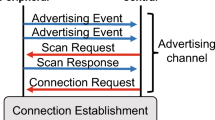Abstract
The performance analysis of the multi-objective pity beetle optimization algorithm for selecting the optimal relay node was discussed in this paper. We take advantage of optimum node selection techniques to improve network communication between primary users (PU) and secondary users (SU) where secondary users are called relay nodes. The objective functions are defined to identify the best relay node in order to achieve the maximum signal-to-interference-plus-noise ratio (SINR) obtained at secondary user. Through considering certain objective functions in the algorithm as a fitness function, optimal relay node is selected. Each chosen relay node function collectively to communicate between source and destination node. The results from the simulations shows that, compared to other evolutionary algorithms the proposed relay selection method provide reduced power consumption, better transmission probability and achievable data rate.






Similar content being viewed by others
References
Mansoor, N., Muzahidul Islam, A., Zareei, M., Baharun, S., Wakabayashi, T., & Komaki, S. (2014). Cognitive radio Ad-Hoc network architectures: A survey. Wireless Personal Communications, 81(3), 1117–1142.
Zhang, P., Liu, Y., Feng, Z., Zhang, Q., Li, Q., & Xu, D. (2012). Intelligent and efficient development of wireless networks: A review of cognitive radio networks. Chinese Science Bulletin, 57(28–29), 3662–3676.
Ren, P., Wang, J., & Li, S. (2010). A dynamic spectrum access network based on cognitive radio. Journal of Electronics (China), 27(5), 577–610.
Zhang, S., Hu, Y., Zhang, L., & Bao, Z. (2018). Novel spectrum sensing and access in cognitive radio networks. Science China Information Sciences, 61(8), 1–3.
Ezzati, N., & Taheri, H. (2018). Distributed spectrum sensing using radio environment maps in cognitive radio networks. Wireless Personal Communications, 101(4), 2241–2254.
Mavromoustakis, C., Bourdena, A., Mastorakis, G., Pallis, E., & Kormentzas, G. (2014). An energy-aware scheme for efficient spectrum utilization in a 5G mobile cognitive radio network architecture. Telecommunication Systems, 59(1), 63–75.
Veeramakali, T., Jayashri, S., & Prabu, S. (2017). Intelligent dynamic spectrum allocation with bandwidth flexibility in cognitive radio network. Cluster Computing, 20(2), 1575–1586.
Zhao, F., Sun, X., Chen, H., & Bie, R. (2014). Outage performance of relay-assisted primary and secondary transmissions in cognitive relay networks. EURASIP Journal on Wireless Communications and Networking, 2014(1), 1–10.
Chen, H., Tan, S., & Zhao, F. (2015). Outage performance of relay-assisted transmissions in cognitive full-duplex relay networks. EURASIP Journal on Wireless Communications and Networking, 1, 2015.
Moghaddam, J., Farrokhi, H., & Neda, N. (2017). Joint Clustering Relay Selection and Beamforming in Cooperative Cognitive Radio Networks. Wireless Personal Communications, 95(4), 3601–3616.
Ruby, D., Vijayalakshmi, M., & Kannan, A. (2017). Intelligent relay selection and spectrum sharing techniques for cognitive radio networks. Cluster Computing, 22(5), 10537–10548.
Tang, X., & Chen, B. (2017). Research on spectrum detection technology in cognitive radio (pp. 295–298). Social Informatics and Telecommunications Engineering: Lecture notes of the Institute for Computer Sciences.
Pandit, S., & Singh, G. (2017). Cognitive radio communication system: Spectrum sharing techniques. Spectrum sharing in cognitive radio networks (pp. 1–33). Cham: Springer. https://doi.org/10.1007/978-3-319-53147-2_1.
Ahuja, B., & Kaur, G. (2019). Two-stage spectrum sensing using fuzzy logic for cognitive radio networks. In Proceedings of the National Academy of Sciences, India Section A: Physical Sciences.
Khatbi, O., Hachkar, Z., & Mouhsen, A. (2018). Cognitive Radio Spectrum Sensing Based on Energy. Advances in Intelligent Systems and Computing, 542–552.
Author information
Authors and Affiliations
Corresponding author
Additional information
Publisher's Note
Springer Nature remains neutral with regard to jurisdictional claims in published maps and institutional affiliations.
Rights and permissions
About this article
Cite this article
Kalaimagal, G., Vasanthi, M.S. Optimal Relay Node Selection Using Multi-Objective based Pity Beetle Optimization Algorithm for Cognitive Radio Networks. Wireless Pers Commun 121, 319–335 (2021). https://doi.org/10.1007/s11277-021-08637-3
Accepted:
Published:
Issue Date:
DOI: https://doi.org/10.1007/s11277-021-08637-3




